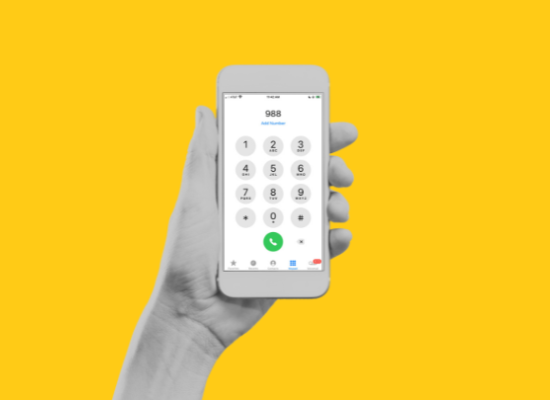
Sue leads the Zero Suicide Institute of Australasia.
There’s not much about Covid-19 that any country would consider favorable. However, for England, the pandemic resulted in the acceleration and expansion of mental healthcare services. Today, this means that in counties across the nation, communities have access to services that only two years ago were, at best, part of a five-year plan.
According to Dr Phil Moore, a London-based general practitioner and clinical co-director for Mental Health London, the long-term mental health plan was always to integrate crisis lines for all ages. “When the pandemic hit, within a matter of a few weeks, all the National Health Mental Health Trusts had a 24/7, all-age crisis line in place as an urgent response to the pandemic,” he says.
The long-term plan was always to use the facility designed into the existing NHS 111 phone service for general health matters, where a person may speak with a health professional about any physical health concern or crisis and be referred to appropriate care. The ‘press 2’ option was intended to take a person directly to a mental health crisis centre and this is now being implemented. In London, this will be operational later this year learning from the success in two forerunner areas.
“Now, in this post-pandemic phase, we’ve got to think how we make this work effectively so that all aspects of mental health services are integrated, and when a person in crisis calls, we’re sure they’ll be put through to the right place without delay or being called back,” says Dr Moore.
A new and critical aspect of the service is a standard triage process where a mental health professional can access various clinical databases. This helps the professional more effectively match the caller to care and helps avoid the all too common problem of the person having to repeat their story and spend precious time responding to routine questions for which the information is already known.
However, while the NHS 111 ‘press 2’ service doesn’t have ongoing responsibility for the person, the triage process, conducted by the mental health professional, ensures a warm hand-over by determining the correct type of service needed by the person at the time of the call. If the situation is acute, London Ambulance Service may be called, or a mobile crisis team may be sent out to the person to do a mental health assessment. Whatever action is taken, after the call, the service sends a text to the person detailing what’s been decided. The same text is sent to the person’s care provider, so they know what has transpired and the actions that were taken to keep the person safe.
While the technology is largely in place, a much more challenging problem for the NHS is to find the staff needed to sustain these services into the future. There’s a large personnel deficit, and most mental health trusts have a vacancy rate. “One of the problems the crisis line will likely have is ensuring people don’t fall to the bottom of a waiting list simply because of workforce challenges,” says Dr Moore.
He says the NHS is trying to appoint mental health staff in many more areas. “Primary care is in the process of appointing mental health practitioners and nurses as well as social prescribers,” says Dr Moore. “There are community mental health teams that need staff, and we’ve got crisis resolution and home treatment teams. We’ve also got the liaison psychiatry in accident and emergency and in-patient and specialist outpatient services that need staff.” Workforce remains the single biggest issue.
Building an integrated system of care is well underway, but for those leading Mental Health London there’s still more to do to ensure a safety net is in place to catch all people with mental health concerns. The large diversity of cultures within the 10 million London population makes this particularly challenging. For example, the city is home to the largest community of Koreans living outside of Korea, and 14.4% of Londoners are Muslim. Dr Moore notes this means mental health providers must have cultural competency. “We must tailor services to a person’s culture, gender, and age,” says Dr Moore. He notes that the demand for services, particularly for children and young people, has escalated.
However, he says the field must not hyper respond by over-medicalising. “Mental distress is normal,” he notes. “We need to educate our communities and young people to understand how they can manage their mental health, so they come out the other end in a good state. I think that’s an important area for us to be working on.”
Further south, taking in the areas of Southampton and the Isle of Wight, Sonya McLean, Programme Manager for Integrated Care System in mental health crisis care, has been responsible for expanding phone services and integrating them with other mental health crisis services. This wasn’t a small task because there are five Mental Health Trusts in the region, and the goal was to create one service, one provider, and one workforce.
“We opened 24/7 in April 2019 and are pleased with the progress,” she says. Since launching, the trusts have experienced a 26% reduction in ambulance-related calls and a downward shift in calls to the general practitioners, from 69% of NHS 111 calls to roughly 10% today. “Our mental health nurses now manage around 1,500 calls each month,” she notes, “and with the nurses’ support, around 89% of those calls are managed with self-care at home.”
Much of the shift is explained by the fact that people can call NHS 111 as many times as they need. With open and ready access, mental health nurses can work with the person to keep them settled, well, and away from the emergency department. Should there be a high volume of calls coming from the same person, the service will review the calls and recommend ways to support the person to maintain good mental health.
Like the London service, there’s consistent interaction between various parts of the mental health service. For example, when a mental health nurse completes a call, they send a message to the person’s general practitioner outlining the call outcome. This might be to see the general practitioner the next day, or it could result in a visit to one of the crisis houses for short stay accommodation or a visit from the home care treatment team.
McLean has worked hard to ensure the nurses in her service have access to all the patient management systems. “The nurses were very concerned that without access to all the person’s records, they wouldn’t be able to support them to the best of their ability,” she says. McLean points out that the rapid data access was also critical to achieving the seamless integration that the service was meant to deliver.
Another critical component of mental health system integration has been creating a dedicated line for police to speak directly with a mental health nurse. As a result, when an officer is called to a person who might have previously been detained under the Mental Health Act, the police officer can speak to a mental health nurse and not make any decisions in isolation. “Together they work with the person in crisis on a care plan and provide the option for them to connect to other parts of the mental health care service,” says McLean.
No matter where a person is located, Dr Moore and McLean say the goal is to ensure the person in need gets the right help in the right place at the right time.
Sue Murray, International Correspondent
A health promotion advocate in Australia dedicated to improving the health and well-being of all people. Throughout her career, she has focused on health for the community and has expertise in communications, education, and organisational development.
Sue currently leads the Zero Suicide Institute of Australasia, which aims to support the healthcare system to understand and more effectively manage those who are vulnerable to suicide and suicidal behaviour.








